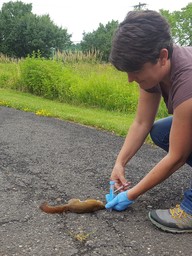|
NJDEP Fish and Wildlife's CHANJ team just finished a 5-year project looking at the functional connectivity of New Jersey's landscape for native mammal species. One part of the project used DNA samples and a gene flow analysis to answer the question, how well are animals getting around in our urbanized state?
|
With help from more than 100 volunteers equipped with sampling kits of scissors, gloves, plastic tubes and data sheets, we collected 1,669 DNA samples from 33 different native mammal species across the state. Most samples were taken from road-killed or legally harvested animals.
Our goal was to sample large and small species with different territory sizes and life histories. For each species we aimed to collect at least 20 samples north of Route 1 (north Jersey) and 20 samples south of Route 1 (south Jersey).
|
|

|
Our samples were processed by the National Genomics Center for Wildlife and Fish Conservation in Montana. Below are maps showing the sample distribution for each of 10 mammal species we assessed in this study:

The analyses show that patterns of gene flow within multiple species across NJ appear to be affected by our human-modified landscape (e.g., roads and development), which limits their ability to disperse. We hypothesize that carnivores like Coyotes and Bobcats may be having the hardest time because of their large area requirements compared to other animals. But landscape "resistance" appears to be an issue for species with smaller home ranges too, including Woodchucks and Eastern Cottontails. This is yet more evidence that habitat connectivity needs attention in the Garden State (visit CHANJ.nj.gov to learn more and find tools to help).

The results also showed that very common, urban-adapted species like White-tailed Deer, Raccoon and Eastern Gray Squirrel are less impacted by habitat fragmentation so far, at least genetically speaking. And Virginia Opossums taught us a new word - panmixia - meaning their genetics are similar all across the state, uninfluenced even by physical distance. This may be due to Opossums' nomadic nature and urban adaptability.
For more of the juicy science behind this study, check out our full report here: https://dep.nj.gov/wp-content/uploads/njfw/chanj-connectivity-assessment-mammals.pdf
A huge thanks! to all the volunteers and participants who collected DNA for this study, and to the Genomics Center for making it meaningful.
Special thanks also go to the U.S. Fish and Wildlife Service's Wildlife & Sportfish Restoration Program for funding our project.
|



